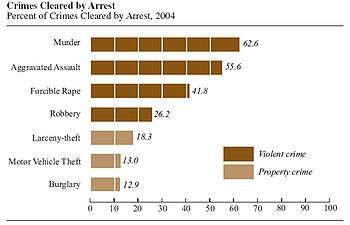Clearance rate
In criminal justice, clearance rate is calculated by dividing the number of crimes that are "cleared" (a charge being laid) by the total number of crimes recorded. Clearance rates are used by various groups as a measure of crimes solved by the police.

Clearance rates can be problematic for measuring the performance of police services and for comparing various police services. This is because a police force may employ a different way of measuring clearance rates. For example, each police force may have a different method of recording when a "crime" has occurred and different criteria for determining when a crime has been "cleared." One police force may appear to have a much better clearance rate because of its calculation methodology.[1]
In System Conflict Theory, it is argued that clearance rates cause the police to focus on appearing to solve crimes (generating high clearance rate scores) rather than actually solving crimes. Further focus on clearance rates may result in effort being expended to attribute crimes (correctly or incorrectly) to a criminal, which may not result in retribution, compensation, rehabilitation or deterrence.
References
- Greene, Jack R. (2007). The Encyclopedia of Police Science, Volume 1. Oxfordshire, United Kingdom: Taylor & Francis. p. 907. ISBN 0415970008. Retrieved 4 August 2019.
Further reading
- Schmalleger, Frank. Criminal Justice Today, An Introductory Text For The 21st Century.
External links
- Wesley Lowery; Kimbriell Kelly; Ted Mellnik; Steven Rich (2018-06-06). "Where Murders Go Unsolved". The Washington Post. Retrieved 2019-10-07. - "The Post has mapped more than 52,000 homicides in major American cities over the past decade and found that across the country, there are areas where murder is common but arrests are rare."